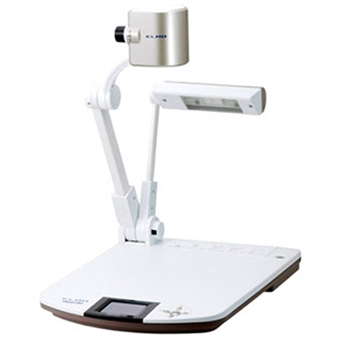
Caption: P30HD 1080P Full HD Visual Presenter
Document cameras, also known as digital visual presenters, allow for interactive visual technology to be used in many different settings. Often found in classrooms, document cameras are also useful in courtrooms, conference rooms, and training facilities.
This type of electronic imaging device displays the image on a computer, LCD or projection screen. The individual parts that make up document cameras affect their connection abilities, image clarity, and more.
Document Camera Parts
The Base
The base serves two functions: stability and power/connections housing. The base is where users can find the power, control panel, inputs/outputs, circuitry and base light.
- Lighting
The base light illuminates the displayed material. An even lighting throughout the entire image is provided by two cold cathode fluorescent lamps on each side of the lighting assembly. Not all document cameras have a light box, and therefore require accessories for lighting needs.
Powerful lighting on a document camera allows for smaller apertures to be used, resulting in an increase in the depth of field that the document camera can achieve. The quality of the light source also affects the noise when the lighting reaches the sensor, which can degrade the image quality.
- Input/Output
When considering the purchase of a document camera, look carefully at the output connection types available. This will determine what type of screen the image can be viewed on and how images can be imported.
- USB
Document cameras with only a USB port must be connected to a computer for display or USB device to import images for viewing.
- VGA and/or HDMI
Users can connect directly to a monitor or projector with VGA or HDMI outputs. Document cameras with these outputs are ideal in a classroom setting.
- VGA and/or HDMI and USB
For flexibility to use any screen for viewing, some document cameras have all three output options.
Connecting Arm
Document cameras can be gooseneck or rigid. Gooseneck document cameras have a flexible arm that connects the camera to the base. This arm also houses the cables needed. The flexibility of the gooseneck arms allows for better viewing of 3D objects and better zoom on documents.
Rigid documents cameras do not allow for free movement of the camera, but some varieties are telescopic to get closer to the object being viewed.
Camera
- Image Sensor
Inside of the camera, there is an image sensor, which is either a CCD or CMOS Active Pixel Sensor. The image sensor provides a monochrome image.
Combined with a 1-chip camera, the color information is obtained through color filters over the pixels. The most common filter is the Bayer filter. It has red, blue and green filters arranged in a pattern with the green pixels twice as large as the red and blue. From there, algorithms are used to input the missing color information to produce the projected image in full color.
A 3CCD camera module produces color images in a different way. A prism separates the white light into red, blue and green. After that, a different sensor is used for each color. 3-chip cameras use this technology to produce excellent color images at a high resolution.
- Lens
Most document cameras are outfitted with a motorized zoom lens. However, they may come with a close up zoom camera lens for better viewing. This allows for focusing and magnifying the material from a short distance. This lens can screw on or be kept in a frame and attached permanently.
Uses
While previously used primarily for printed materials such as documents, books, or slides, they can be used to view almost any object imaginable. More recently, they have been used in applications to project 3D objects.
Displaying material for learning, training, or video conference applications is easy with a document camera. AV Superstore can help you find the right document camera for your needs.
